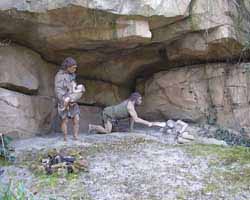|
Origins of herbal medicine
Introduction[Top] So what are the origins of herbal medicine? I will start my explanation with otzi the iceman. Otzi the iceman[Top]  Otzi the iceman was discovered in September 1991 in the Ötztal. Alps in the Schnalstal glacier. He is the oldest human mummy in Europe. Otzi the iceman was discovered in September 1991 in the Ötztal. Alps in the Schnalstal glacier. He is the oldest human mummy in Europe.
There were two types of polypore mushrooms found amongst his personal effects. One of these is known to be the birch fungus. The birch fungus has antibacterial properties; it is more than likely it was used for its medicinal properties.
Neanderthals knew about herbal medicine[Top] Nine Neanderthal skeletons were discovered in a cave located in  the Zagros Mountains of Iraq. The skeletons are dated between 60 to 80,000 years BP. the Zagros Mountains of Iraq. The skeletons are dated between 60 to 80,000 years BP.
One of the skeletons was discovered lying in a grave deposit. Through soil analysis it was discovered that flowers were put together with the body. A further study revealed the flower types. They were
All these flowers have medicinal properties and have been known to be used in herbal medicine.
How do animals self medicate?[Top] Now I want to go back even further for an answer to what the origins of herbal medicine are. It is a more than reasonable suggestion that herbal medicine was learned about by watching animals self medicate. A process known as zoopharmacognosy But how about animals how are they able to self medicate? How do they know the right substance to digest? It is generally thought that animals evolved from a flagellated eukaryote. Flagellates are cells with one or more whip-like organelles called flagella. Their closest known living relatives are the choanoflagellates, collared flagellates that have a morphology similar to the collar cells of certain sponges. According to molecular studies, animals are in a supergroup known as opisthokonts. This group also includes fungi and choanoflagellates. So my theory is that animals know how to self medicate because the knowledge was passed down to them in various stages of evolution. From flagellated eukaryote to present day animals. That might be a far out theory but it is one that would make sense to me. The lifestyle of wild animals have not changed, they still have to hunt, look for food. Humans are largely no longer hunter gathers in the way we once were. I think for the majority of us our senses are not as acute as they once were. We no longer have to hunt for food to survive. We no longer have to walk through forests, jungle etc and identify which plants are poisonous and which ones are safe. That ability which seemed also most instinctive is now found in only indigenous tribes.
Return from origins of herbal medicine to natural healing home
|
Loading



